This week, all the news was again about the coronavirus. First of all, because of it, many events are canceled, including Google I / O, a developer conference that annually showed us the latest developments in the field of software, including Android. Of course, this is unlikely to affect the release of new versions of the operating system, but there is such a possibility. Because of the same virus, the premiere of a new James Bond film was postponed, but we found out which smartphone he would use. And this week, which ends with three weekends, also brought us a dark theme on WhatsApp and more. In general, there is something to talk about. Let's begin.

Traditionally, most of the news is about Google.
Google taught Google Assistant to read text on the screen aloud
Despite the fact that I frankly do not like the robotic voice of Google Assistant, and Alice, for my taste, sounds much nicer, I cannot deny him unprecedented opportunities. Over the years, Google's voice assistant has evolved into a super-convenient concierge who knows the answers to any questions and is able to execute a wide range of commands that are not available to competitors. I think even if Google decided to freeze the Google Assistant project for a couple of years, and then defrost it again, it would still be more functional than everything else. But of course, the company will never do that because the assistant still has a lot to learn.
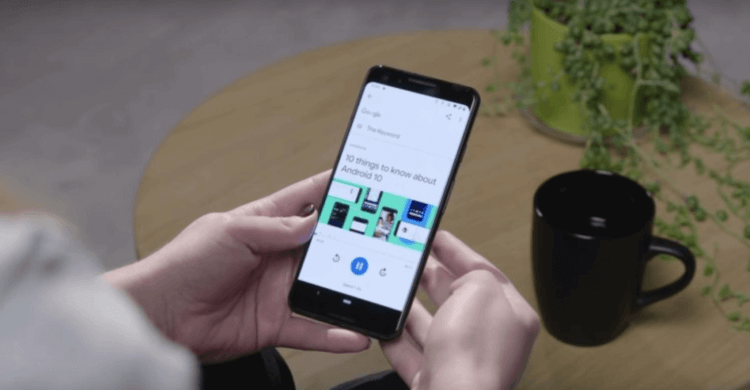
Google Assistant has learned to read text aloud.
This week Google introduced the Reading feature for Google Assistant. Thanks to it, the assistant will be able to read aloud the contents of web pages and running applications. He doesn't care if there are other elements on the screen besides text, he will automatically analyze the content, discard all unnecessary and start reading, observing punctuation marks and pauses. This function is useful for visually impaired people, as well as in situations where it is not possible to hold the smartphone in front of you and read the text yourself. And why, if you can just ask?

For Google Assistant to read the text on the screen, you must first open the desired page in a web browser, and then call the assistant either by voice or by pressing the corresponding button and say: 'Read this' or 'Read'. By and large, the wording that you use when giving a command to an assistant does not matter. He understands the context perfectly, allowing you to use any words you deem appropriate. Nevertheless, it is still better not to scare yourself, checking the knowledge of Google Assistant, but to formulate the command as simply as possible.
While reading, Google Assistant will keep listening to the user, making the process interactive. Thanks to this, you can ask him to repeat what he read or switch to the next block, if we are talking about, for example, reading a recipe while cooking. In addition, you can manually change the reading speed and make other adjustments to improve the reading experience. After all, not everyone likes measured reading, someone wants to quickly hear what is written and analyze it.
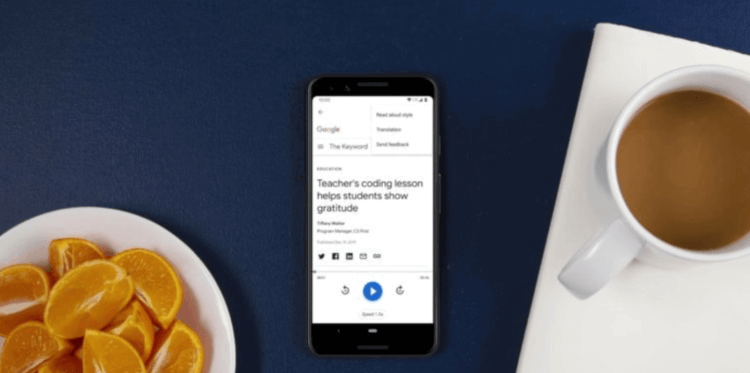
Google Assistant reads in 42 languages.
To make it easier to understand the assistant's speech by ear, Google developers had to work on his pronunciation, teach the correct placement of stress, pauses and even expression. Of course, as far as possible, since Google Assistant is one of the few voice assistants that uses computer-synthesized voice, rather than using voice actors like, for example, 'Alice' from Yandex, Siri or Cortana from Microsoft. Therefore, of course, it will still not be possible to avoid flaws when reading 100%.
Google Assistant can read text in 42 languages, including Russian. However, now, while the new function is distributed only in test mode, only owners of Google Pixel smartphones will be able to use it. Therefore, if you are the proud owner of one of them, you can try the innovation right now. After a while, it will reach all devices not older than five years. The only condition is support for Google services in general and Google Assistant in particular.
What smartphone will James Bond have in the new film
Probably, there is no one among gadget lovers who does not know that the international exhibition MWC 2020, which this year, as usual, was to be held in Barcelona, was canceled due to the coronavirus raging in the world. This led to the fact that many smartphone manufacturers were forced to postpone the releases of their devices to other dates. We have already seen some of them, some are still waiting for us, but one brand will present not just a smartphone, but a real collaboration with James Bond. Considering the manufacturer, such a move would look like a desperate attempt to reclaim the credibility that has left much to be desired and grab the attention of buyers. Who will it be? And most importantly, why?

What will his new smartphone be like in the movie?
The correct answer would be “no one showed smartphones at MWC 2020,” for the reason described above. Among them is Nokia. Now the time has come and the company has sent out invitations to the presentation on March 19 in London. There is a feeling that this will be another failure, but more on that below.
In general, the fact that the company did not show its smartphone at a major international exhibition is a very unpleasant moment. Of course, for her, not for us. All due to the fact that several hundred people will look at it at a special event, and tens of thousands at the exhibition. And just to attract attention during such a large thematic event is easier than just holding an event.

The invitation itself looks like this
The invitation itself does not give an understanding of what we will be shown. As usual, it is intriguing and simply intended to attract attention. The collaboration with the creators of the James Bond series should attract even more attention. Information about this was published in his Twitter by the director of HMD for products Juho Sarvikas.
This is not the first time that the Nokia brand has wanted to appear in Bond, but the first time that it actually takes place. Unless, of course, this is a false hint.
It is still impossible to say for sure which smartphone will be shown to us, because there is very little information so far, but, apparently, it will not be the most sophisticated flagship, but a device of approximately the middle segment.
It is supposed to have 4 cameras, 64 GB of ROM, 6 GB of RAM and a fingerprint scanner on the back. All this “beauty” will cost about $ 180, which does not mean the top-end component of the device.
On the other hand, no one says that this device will be the only one that will be shown at the presentation. There is a possibility of 5G – a smartphone with Snapdragon 765 on board.
It is not yet clear how the famous British intelligence agent will be involved in the process, but it is possible that this smartphone will appear in the film itself. Although it is difficult to assume that Bond will use it on an ongoing basis. Most likely, he will break it, take it away from one of the opponents, or simply receive it as a spy device, which he uses only once at the end of the film.

But he can break it.
This option looks the most realistic. Although, perhaps everything will be limited to just the right to mention the name of the painting at the presentation or the release of a limited edition with the numbers “007” on the back wall.
In any case, for a brand that is trying to stay afloat with grief in half, such cooperation is unlikely to be cheap. Although the James Bond films have lost some of their former popularity (but not as much as Nokia), advertising in them is expensive.
We all remember how Nokia tried to remind of itself with “bananas”, 3310 reincarnations, smartphones with a huge number of cameras and even rumors about the imminent release of a foldable smartphone. But this is unlikely to save them. Only a few good and inexpensive smartphones can save them. The problem is that it is very difficult. Although, the Chinese, which is HMD, are no strangers to bringing smartphones to the market using this strategy.
So far, apparently, they are preparing another walk-through model, which will definitely not distinguish them from competitors. It's a shame, because as long as they have a name and they can play on it and release something like Realme X2 Pro for little money and hit the jackpot.

A good smartphone is good for an ordinary person.
In general, returning to Bondiana, shooting a device in a picture is a fairly popular move. Displaying other big brands in a way that gets noticed but not seen as advertising is very difficult. This is due to the fact that not all of them are used in life all the time, unlike cars and smartphones.
This is exactly what can be shown in the frame, promoted at the presentation and even released a limited version. Of course, this does not always happen that way, and sometimes the technique is selected by props specialists, not marketers, but more often than not this happens for a reason.
The new Bond film was supposed to be released on March 31, 2020 in the UK and on April 9, 2020 in Russia. But due to the coronavirus and low turnout in cinemas, the premiere was postponed until November. The main role, as in the last few films, will be played by Daniel Craig. Rami Malek will also star in the film, one of whose recent roles is the role of Freddie Mercury in Bohemian Rhapsody.
Many even a couple of months ago said that the release of the film, ironically, was not very timely. It's called No Time to Die. Given the situation in the world, such a name looks a little ominous. Largely because of this, even a month ago, the presentation of the film in China was canceled. Now the entire premiere has been postponed to a later date.
From such coincidences, one can recall the release in 2002 of The Lord of the Rings: The Two Towers, which was released when the memories of the September 11 tragedy were still fresh, in which two towers of the World Trade Center in New York were destroyed. Then, too, many discussed the relevance of such a name. In some countries the title of the film was translated using the words “two fortresses”, including in Russia.
Let's see how events will develop, and how deeply Nokia has “partnered” with the creators of the famous franchise, but I think that this will not help them much.
WhatsApp for Android got an update with a night theme. How to turn on
The night theme is a highly overrated phenomenon. Despite the fact that it can really save a few percent of charging, it is completely unsuitable as a means of eye protection in low-light conditions for which it is being passed off. And the point here is not at all in my personal perception, but in objective factors. However, this does not prevent users from craving for the appearance of the night theme, and developers to satisfy their needs, making money on it. WhatsApp is no exception.

WhatsApp for Android got a night theme. Finally.
Rumors of a night theme on WhatsApp began circulating long before Android 10, where the night theme became a system-wide tool. Nevertheless, the developers of the messenger were in no hurry to match the environment in which their offspring works, and then they spent a long time testing and debugging the night theme. The beta test alone is worth it. WhatsApp, although it admitted a fairly wide circle of testers, consisting of several thousand users, it lasted so long that many even stopped hoping that the night theme would ever be released. However, this week their dream has come true.
Unlike WhatsApp for iOS, which was released immediately and for everyone, the version for Android is being distributed gradually and may not yet be available to some users. Obviously, the developers are not yet sure about the stability of the night theme and want to hedge themselves in case the first ones who downloaded the update encounter any problems. After all, it is much easier to recall an assembly that is used by several thousand people than if hundreds of millions around the world have access to it. So the work of the whole service will not be paralyzed for long.
Another difference between the WhatsApp version for Android and iOS lies in the principle of enabling the night theme. If there is no separate switch on iOS in the messenger, and the night theme in the messenger itself depends on the work of the system night theme, there are slightly more activation options on Android. In addition to the system night theme from Android 10, which forcibly includes the night theme in WhatsApp, users of earlier OS versions have the ability to force the night theme on in the interface of the messenger itself.
- To enable the night theme in WhatsApp, launch the messenger and open the context menu;
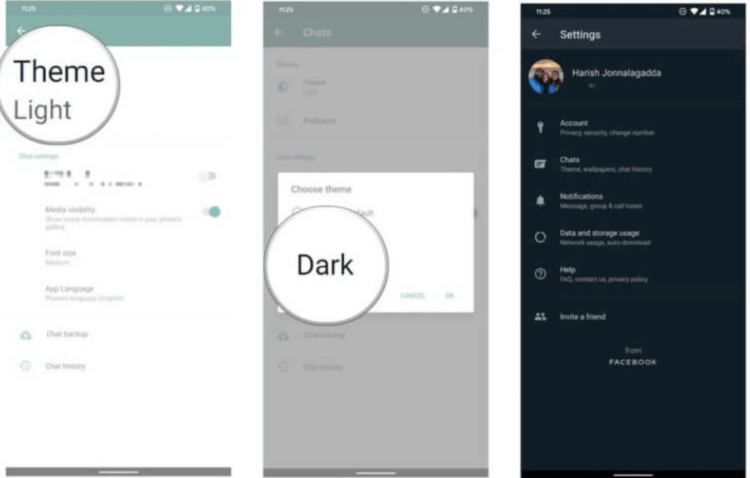
In WhatsApp on Android the night theme can be turned on forcibly.
- Go to 'Settings' – 'Chats' – 'Themes';
- In the window that opens, select 'Dark' and confirm its inclusion with the 'OK' button.
In fact, it is not unusual that the developers decided to embed a forced activation button for the night theme in WhatsApp for Android, although there is nothing like that in the version for iOS. The reason for this, oddly enough, was a large number of smartphones running on the basis of already non-renewable versions Android. After all, if WhatsApp opened access to the night theme only to users Android 10, it would be completely illogical, since there are significantly fewer of them than everyone else. Therefore, in this case, the banal power of the majority worked, and not the special attitude of WhatsApp developers towards users Android.
Why was Google I / O canceled?
A bad trend has emerged recently. Events are canceled one by one, and the companies that were supposed to participate in them lose money, thrash their plans, shift the start of sales of their products and suffer reputation losses. So we have already witnessed the cancellation of MWC 2020, the Geneva Motor Show and some other thematic events. Exhibitions are generally a separate topic, since they are already on the verge of losing interest in them, and such shocks can only push them to the edge of the abyss. Another thing is the Google I / O conference, which was supposed to take place, but was also canceled. At least the physical, most interesting part of it. What's next and what does it promise us?

There will be no conference this year.
For those who don't know, the coronavirus has been raging around the world in the past couple of months. At the time of this writing, there are already more than 90,000 infected people in the world and more than 3,000 deaths from the consequences of infection. Maybe the percentage of deaths is not so high, but the virus is not fully understood, and the scale of its spread frightens not only WHO, but also governments and event organizers who do not want to risk and gather tens of thousands of people under one roof.
Against the background of all this, exhibitions are canceled one by one, like balloons bursting in the prize dash of a park. But in the beginning, large exhibitions were canceled, and now even local conferences, albeit significant ones.
The only good news is that the event is not completely canceled, but only its physical part, which was supposed to take place in Mountain View and for which tickets have already been raffled off. All this was done on the basis of WHO recommendations and the company's own concerns.
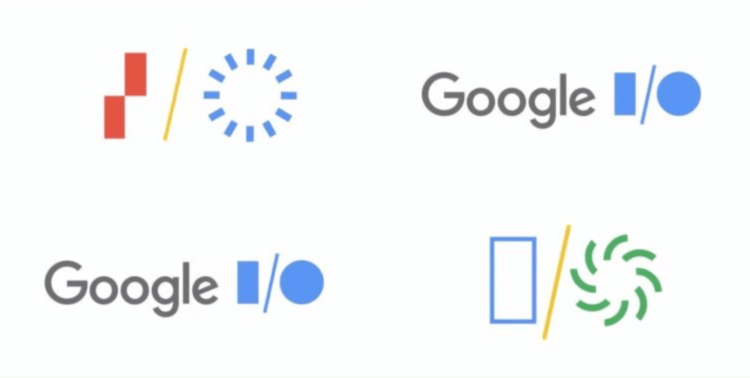
Now this creative poster has become history.
At the moment, alternative options for holding the event are being looked for, since it is a little impractical to cancel it completely. And the company has already ceased to adhere to the original dates of the conference. Let me remind you that it was supposed to take place on May 12-14. Perhaps the dates will be postponed to a later date.
In addition to I / O 2020, Google has revised some of its other events. Some of them were held or will be held online, and the rest will be canceled altogether.

And so everything was beautiful …
Don't worry that Google won't be able to host such a large event online. They have everything they need as the conference is streamed annually on YouTube. Also, all the necessary information can be found on the event website.
Above, I wrote that exhibitions may be on the verge of extinction after what happened this year. This makes a certain sense and should not be underestimated.
First of all, it should be understood that while the interest of manufacturers of electronics and other consumer goods is quite large, but it is rapidly falling. It is big due to the fact that at exhibitions you can more fully show your new product. Yes, you can catch up with hundreds of journalists, show them a novelty and wait until they write about it. The problem is that these will be ordinary walkthrough articles or reviews that people who are far from technology, but still potential buyers, may not notice.

The Geneva Motor Show was canceled just a few days before the start
The exhibitions are attended not only by hundreds and thousands of journalists who will also write about the new product, but also business representatives who can conclude a major contract, and ordinary technology lovers. All this greatly increases the audience. Even those who do not follow thematic publications are still more likely to hear about new products.
From this point of view, everything is good and the exhibition has a great and bright future, but the problem is that distribution channels are developing and advertising is becoming targeted. As a result, a situation may soon arise in which exhibitions can be compared to shouts in the street, and other types of advertising – with an appeal to someone who really wants to buy a particular product.
So the prospects of exhibitions become less rosy and unnecessary shocks in this matter are not needed, because a chain reaction can go on and even events that seem to be unrelated to each other will pull each other along and there will be no more exhibitions. I would not like …
The nearest major event from the world of gadgets should be the presentation of the new Huawei P40 Pro. Usually the presentation of smartphones of this line looks very large-scale and hundreds of journalists and bloggers from all over the world gather on a large platform. If it goes on like this, the presentation could go online, similar to how the company recently showed its new laptops and tablets on the days when MWC 2020 was supposed to take place.
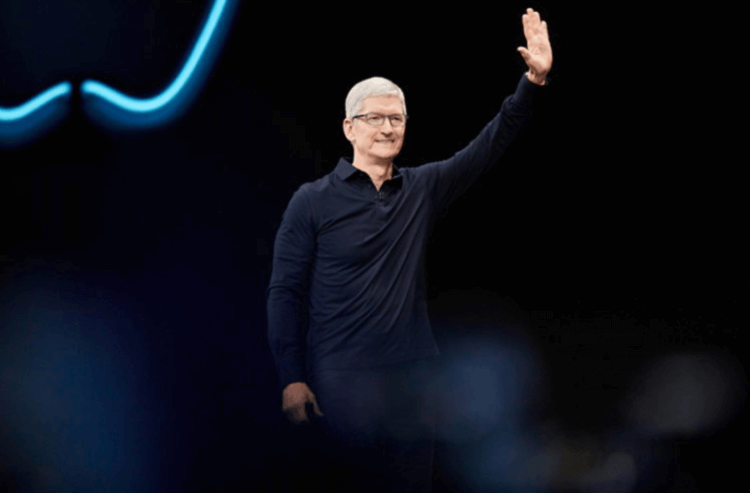
It is not yet fully understood, but a lot can be canceled. Even simple presentations including Apple.
A couple of months after that, there should be a conference Apple WWDC 2020, which is held annually for several days and during which new versions of the operating system and some other chips are shown.
That's not all. Then there will be a presentation of Samsung Galaxy Note, a new one iPhone, and there may be events planned that we do not even know about. All this looks very sad and I want to believe that the situation will calm down, doctors will find a way to resist the virus, and large companies, whose events we are waiting for, will be able to find a way to hold them. Even online. The main thing is to be interesting. Is not it? Throw in the comments options of how you see the future fate of exhibitions and how, in your opinion, manufacturers will act with upcoming presentations and conferences.
When will OnePlus 8 be shown
Remember the ecstasy of the audience when the first generation OnePlus came out? They were not just good, but they offered the most advanced technologies for the minimum money. The price could be two or more times lower than competitors. At the same time, smartphones also offered great customization options, constantly received updates and were the things that united not just smartphone lovers, but real enthusiasts in their field. Those times began to gradually pass with the release of new models, which cost more and more, gradually approaching the leaders. We now know when the new OnePlus 8 will be out, but does it generate the same enthusiasm it did during the second and third model?
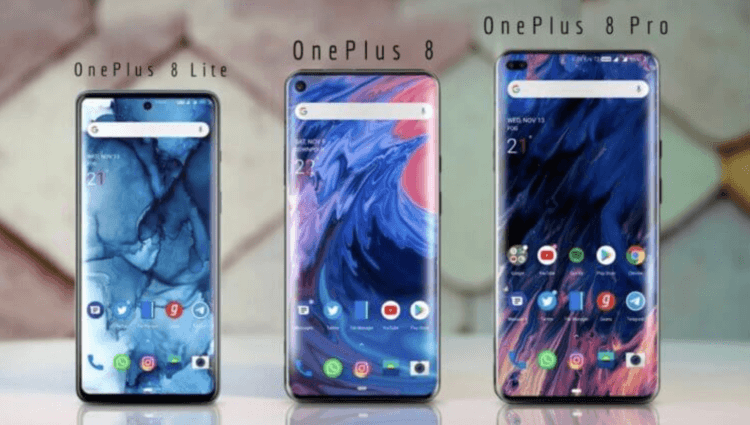
There will be three new OnePlus.
Of course, before reproaching the company, it is worth understanding that with such a start there are only two ways. The first one leads nowhere, after LeEco, which tried to shoot with top-end hardware for a penny, having big ambitions and almost believing in her success. There is no need to talk about where they are now, although their devices were not as bad as many think, and they definitely cost their 10-15 thousand rubles.
The second way looks more promising from a business point of view, if everything is done correctly and on time, but almost never brand fans will be able to accept it with understanding.
Personally, I have no complaints, I believe that this approach is correct. The company showed the whole world who she is by giving away its smartphones almost for free, gradually gaining user reviews to improve software and hardware. Now that its devices have begun to compete with recognized leaders, it's time to beat back investments and start earning. Everything is fine, you just need to stop pretending to be Robin Hood, who still thinks only about people.
As a result, we have what we have, and OnePlus no longer costs a couple of hundred dollars, but almost a thousand. But what will happen to the eighth generation?
OnePlus 8 will be unveiled in the first half of April, TechRadar reports citing its sources at the company. Most likely, the presentation will be global and the smartphone will go on sale simultaneously in all markets. Although, it remains a small mystery which gadgets will be shown at the presentation.
Apparently, there will be three of them. These are OnePlus 8 Lite, OnePlus 8 and OnePlus 8 Pro. It seems to me that such a division of the line looks as logical as possible, in contrast to the use of letters that do not mean anything or generally spaced by different numbers.

There is definitely no doubt about one thing – the smartphone will look good.
The appearance of the Lite model looks even more relevant against the background of the fact that buyers are used to updating to the current line, and not last year's at a discount. It is the lite version that allows no one to feel like an oldfag. Even Apple understood this and released a full-fledged eleventh family without any “R” and last year's models.
Apparently, OnePlus 8 will have a somewhat unusual angular design. It will most likely have a 6.4-inch screen with a hole for the front camera. In this case, the refresh rate will not be lower than 90 Hz.
The camera is also expected to have a triple main camera module. True, two of them will be traditional – super wide and just wide, and the third will be the ToF sensor. There is almost no other data, except that the smartphone will work under the control of the chipset MediaTek Dimensity 1000.
As for the OnePlus 8, it's worth noting that it will have a larger 6.6-inch display. In this case, the screen will be curved, and the front camera will move out of the body, and not spoil the geometry of the screen.
The screen resolution will be Full HD +, but the refresh rate will most likely reach 120 Hz. There is no information on the processor yet, but the camera will be similar to the one used in the OnePlus 7T Pro. There will be three modules in it. In addition to the main one, there will be a super-width and a telemodule.

Different versions of OnePlus 8 will have different cameras.
There is a bit more information regarding the OnePlus 8 Pro. The screen resolution will be QHD + at 120Hz refresh rate, and the Snapdragon 865 will be responsible for the performance, possibly even with a chip supporting 5G. There will be four main cameras. Tele, shirik and ultra-wide plus ToF.
The main characteristics of the smartphone are listed above, but it should be noted that the new product is likely to include wireless charging and IP certification. That is, the protection against water and dust will now have a clear classification.
If you subscribe to our Telegram news channel, then definitely don't miss the release of the new OnePlus and other smartphones.
The second point is especially comical, since some time ago the company's management assured that certification costs money and no one needs it, and only increases the price. Have your priorities changed? If this really happens, then this is all there, to the conversation that someone is building a company of himself exclusively for people. However, while we do not know for sure, and all the cards will be revealed at the presentation.

We will find out more details about the new smartphone soon enough.
Earlier there was information that the new product in the Pro version will cost about $ 1,000. On the one hand, it's like other manufacturers, but for this money you can already buy Samsung S20, and Huawei Mate 30 Pro, and even iPhone 11 Pro. I'm not talking about the OnePlus sisters in the BBK family, which are OPPO and VIVO, which also have decent models, sometimes even for less money. Of course, I'm talking about prices for Europe and Russia, which will be higher than Chinese and American ones.
Until I was convinced that I needed this smartphone for that kind of money. It has no revolutionary design, no outstanding performance and it is not even known what kind of camera it will be. Perhaps after the presentation I will change my mind, but so far it looks exactly like this. What are your thoughts on the new OnePlus 8? Are you waiting for him? Ready to buy it in the top version for almost a thousand dollars? Or is OnePlus not the same one and is it time to take it as another smartphone from many?
